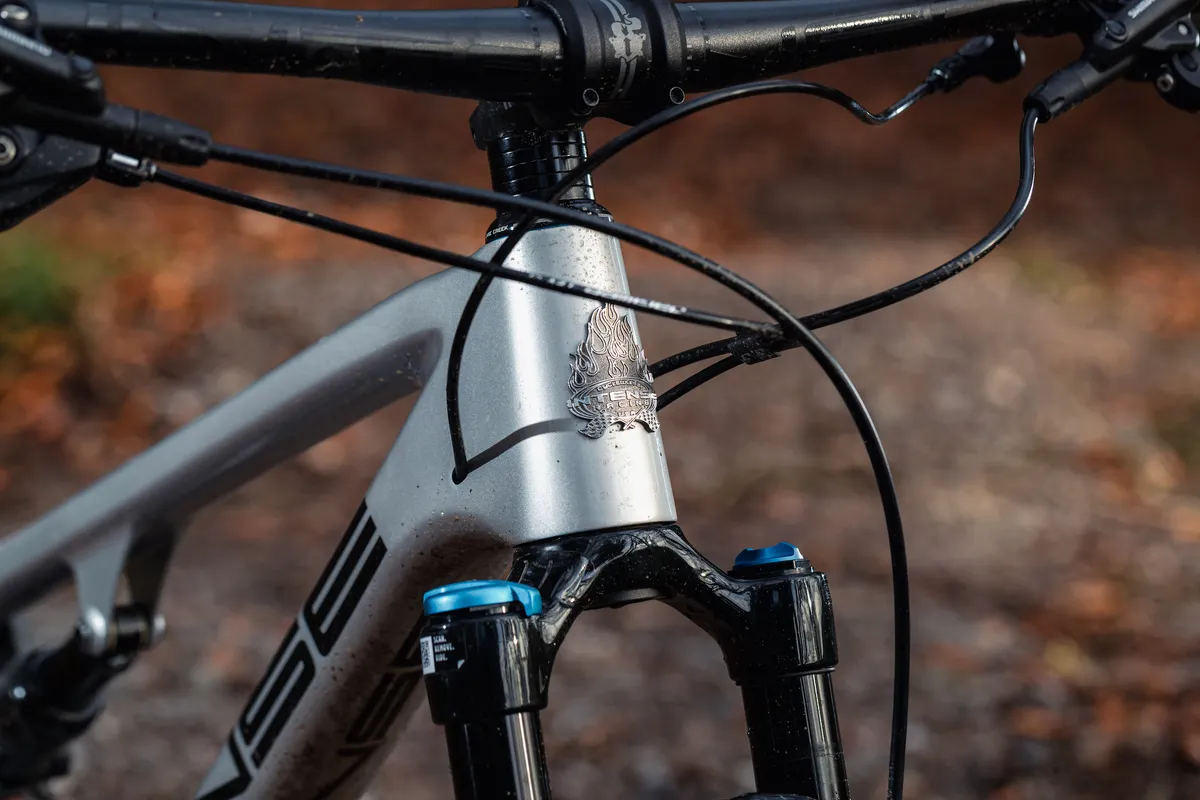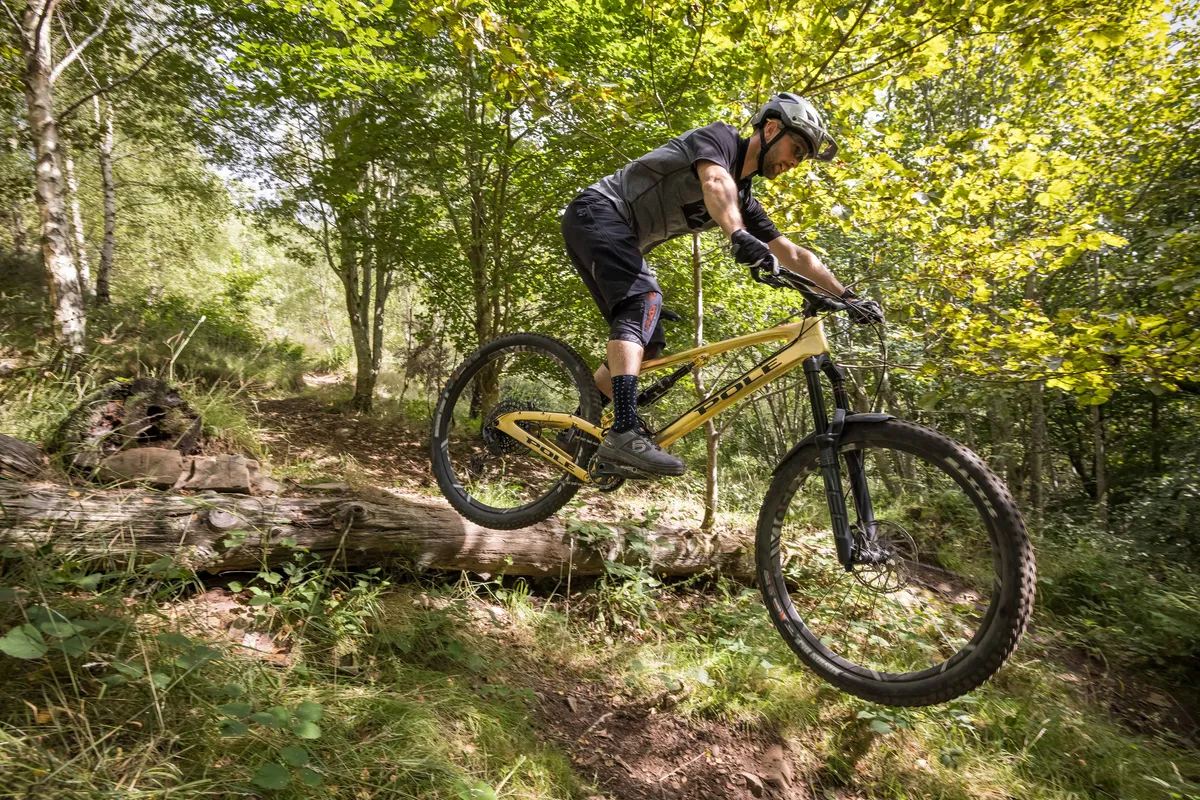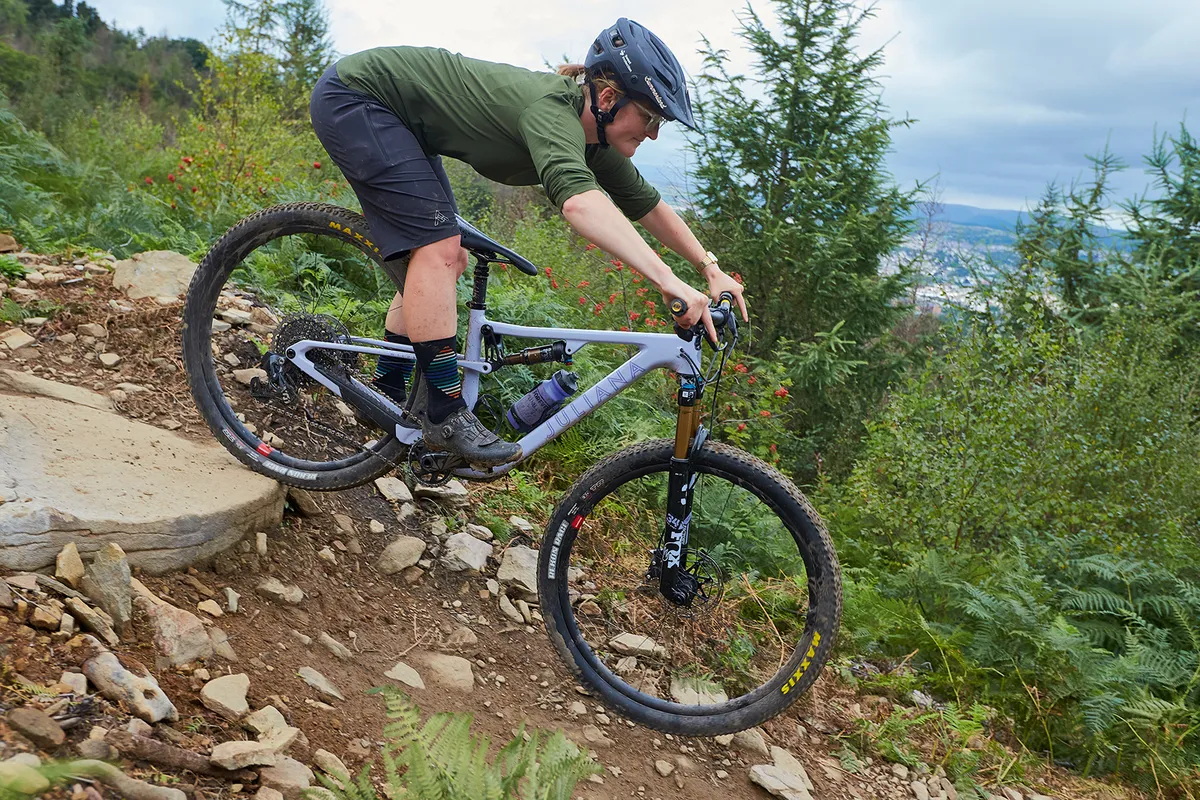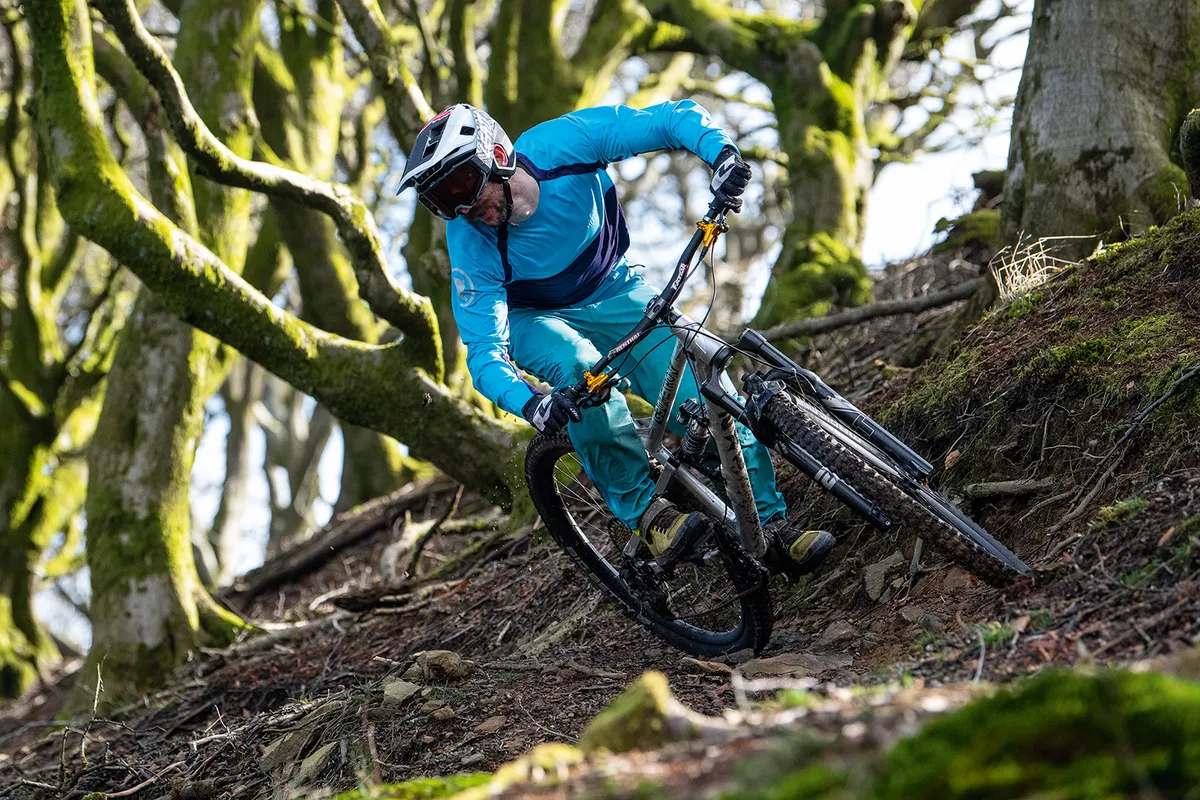Mountain bike geometry has taken significant leaps and bounds in the last few years, with long, slack, low figures – referring to wheelbase and reach, head tube angle, and bottom bracket height respectively – now commonplace on a vast number of bikes across a range of disciplines.
Progressive geometry is often cited as improving a bike’s stability and handling, with more pronounced body movements and weight shifts needed to get it to change direction or line.
This, in turn, means a bike’s chassis is affected less by how bumpy or gnarly the terrain is, or how fast a rider is going, and reduces the effects of erroneous rider inputs. In theory, it makes bikes easier, calmer and more stable to ride.
Although the progress of change was initially slow when it came to progressive mountain bike geometry, the pace has picked up. This has led to a convergence of geometry numbers where, by and large, models intended for the same discipline from different manufacturers share certain figures.

Of course, every discipline has its own requirements – we don’t see super-slack 63-degree head angles on thoroughbred cross-country race bikes, yet – but the fact that different bike brands are offering similar figures on their bikes points to a sweet spot.
Yet there are still some outliers.
Finnish brand Pole and Nicolai’s Geometron are two good examples, with long, slack, low geometry taken to the next level – and there are very vocal proponents shouting about the advantages of this type of bike.

Still, progressive geometry, it seems, is here to stay – but is progressive always appropriate?
Will a beginner who’s riding a £500 mountain bike also benefit from new-age geometry? And should Olympic cross-country mountain bikes have 63-degree head angles? Or is extreme geometry best suited to extreme applications?
Our team of technical experts have assembled to chime in on what they think today’s mountain bike geometry should – or shouldn’t – look like.
Alex Evans – technical editor
Geometry is the free upgrade to unlock untapped potential

Bike geometry is one of the cheapest upgrades a manufacturer can make to its frames.
As long as the manufacturer is designing a bike from scratch, rather than doing some kind of mid-life cycle iterative update, choosing to design a frame with a 63- or a 66-degree head angle is, in effect, costless. So is increasing a reach figure or wheelbase number.
Except for the extra material required to make the tubes bigger, what additional costs are associated with that change beyond the prototyping and development associated with any new bike? I can’t think of an example where an extra-small bike costs less than an extra-large because it uses less material, although in our nickel and diming economy, it wouldn’t surprise me if that became a ‘thing’.
Changing a bike’s geometry, therefore, is not quite the same as devising a new carbon fibre blend or up-speccing the forks, derailleur, bars and wheels; the things most commonly touted as impactful upgrades to justify price increases.
Giving a bike long, slack, low geometry will have the biggest effect on how much fun any given rider can have without any associated costs.
And that’s the crux of my point: progressive geometry will benefit the beginner as much as it already benefits the experienced enduro racer.
So why do we see budget bikes with geometry from the dark ages?
The argument has long been that less progressive geometry – shorter, steeper, higher – makes bikes easier to flick around, change direction or manoeuvre.
And while that’s true on the face of it, it also follows logically that bikes with these geometry figures will be less stable, more easily knocked off-line and harder to ride at speed.
For beginners, that’s a bit of a problem.
Better technique, more skill and the confidence that comes with experience are required to keep shorter, steeper bikes pointing in the right direction.
So, is longer, slacker, lower geometry always better? For me, it’s a resounding yes.
I’d like to see this cost-neutral upgrade implemented across the board on cheaper and beginner bikes.
The benefits of increased stability, more control and, in turn, higher speeds – read: more fun – significantly outweigh the perceived benefits of quicker handling on steeper bikes.
Of course, there are limits as to how progressive a beginner-focused bike should go, but they need to be pushed in the first place so we can figure out where they are.
I suspect that head angles between 63 and 64.5 degrees, seat tube angles between 76 and 78 degrees, reach figures that settle between 475mm and 490mm for a size large bike, and chainstay figures between 440mm and 455mm are where most bikes should eventually settle.
Of course, I could be wrong…
Luke Marshall – technical writer
Progressive is best? Yes… and no

Is progressive geometry better? Well, yes and no. Ultimately, it depends on a rider’s perspective and point of comparison.
Mid-to-high-end bikes released nowadays are certainly faster and arguably offer an improved rider experience compared to bikes of 10 years ago, thanks to the trend for longer, lower and slacker geometry.
Are they more fun? Well, that’s debatable, because some of my fondest riding memories stretch back 20 years.
Would entry-level bikes provide a better riding experience if they shared the same geometry as more progressive high-end bikes? I reckon so. Today’s trail bikes offer more stability, better handling and greater control than the old-school geometry that cheaper models still sport.
Geometry should be on-par for bikes across the entire price spectrum to give all riders the best experience.
There is, however, a limit to all of this. Would today’s mainstream trail or enduro bikes be even better if the geometry continued on the trajectory of the past decade and became even longer, lower and slacker? It’s a no for me.
Low is a trend I can get behind because it improves both fore/aft stability and lateral agility. The best of both worlds. Riders spending time learning pedal placement in tech terrain is a worthy sacrifice for me. And a bash guard doesn’t add much weight.
However, while as a short-arse at 173cm (5ft 8in) I understand my perspective on long and slack might be somewhat biased, it does make it easier for me to find bikes I think are ‘too long’.
For reference, my preferred geometry numbers are around 460mm for reach, 440mm chainstays, a 64-degree head angle and 340mm-ish bottom bracket height. Give or take a little each way. With those numbers in mind, a 190cm (6ft 2in) rider would be on a 505mm equivalent reach.
Extending the reach, and combining that with a super-slack head angle, throws the front wheel way out in front of you. Even with extended chainstays, long bikes tend to have a more rearward weight balance.
This means you have to actively shift your weight forwards when riding to get the front wheel to behave as it should.
Not only does this mean supporting more weight with your upper body, which makes riding more fatiguing, it also takes a healthy dose of commitment and technique to do it well, something novice riders may naturally lack.
Without really getting your weight committed to the front wheel, understeer is easy, causing you to brake mid-turn and only adding to trail woes. Without an aggressive posture and good technique, very long bikes can, in my experience, cause more harm than their stability does good.
That’s not to say I think bikes should go backwards – geometry these days has found a pretty good middle ground that does most things very well nearly all the time.
But ask me this question again in another 10 years and you might get a very different answer.
Rob Weaver – technical editor-in-chief
Extreme bikes have pushed the mainstream in the right direction

While this is a very complex question that’s difficult to wrap up into a one-size-fits-all answer, longer, lower and slacker bikes are, for the most part, better, even for a stumpy little fella like me.
What’s more, if you were to travel back 10 years and ask me the same question, I’d have screamed “Yes” at the top of my lungs when answering.
Why? Well, despite an abundance of long-travel trail bikes (which soon got re-badged as enduro bikes), the geometry was, in most cases, really quite conservative. I mean, back then, we were riding down insanely fast Alpine descents on bikes with numbers closer to modern day cross-country bikes and bottom brackets so far off the floor you could drive a car underneath them.
Jump back on a bike from a decade ago and, while it’ll work just fine and still go fast, I’ll bet you won’t feel as brave when the speed picks up or the gradient steepens.
Thankfully, bike geometry really started to change (a lot) for the better not long after this and the boundaries of what was possible soon began to shift.
With the likes of Chris Porter and his Nicolai-made Geometron frames, the industry started to really take notice of how a trail bike could benefit from geometry figures closer to that of a downhill bike.
Admittedly, those super-slack and long bikes didn’t always excel on every trail. Get one pointed down something steep and confidence levels would skyrocket, while on the flip side, when the terrain was a little less extreme, such stretched-out machines could dull proceedings a little and weren’t always as playful.
But crucially, what those extreme bikes did was help to start a revolution. Soon enough the bigger, mainstream brands took notice and started experimenting with their own side projects.
Before we knew it, average reach numbers for a medium shot from 425mm to 450 or 460mm, head angles were raked out to within one degree of most downhill rigs (most enduro bikes now sport a head angle in the region of 63.5 to 64 degrees).
In a bid to allow us to corner with more confidence, bottom brackets have also got lower (though are creeping up again with suspension travel on the increase for these types of bikes).
All things considered, I very much like where the envelope-pushing trailblazers have taken modern-day mainstream geometry. What was once ridiculously long and slack is now more or less the norm.
Why wouldn’t you want to feel safer, more confident and faster on your bike? I know I do.
Tom Marvin – technical editor
We’re in the sweet spot

Without wanting to repeat Rob’s feelings on the matter, I have to agree broadly.
Times have changed and bikes have now, in my opinion, reached a real sweet spot.
I remember riding a Geometron for the first time. It was a dank, grey, wet day in South Wales, and Chris Porter took me to a hillside I’d never ridden before. Now, South Wales’ hillsides are notoriously steep and Chris being Chris, this was one steep hill.
The bike was longer than anything I’d ever ridden – by a huge margin – and it’s safe to say I’ve never ridden such steep tracks, blind, so well.
From this experience, one might expect me to be on Alex’s side of the argument – bikes should be really long and low and slack – after all, the Geometron utterly flattered my riding that day.
But I’m not.
Those bikes have their place and there’s no doubt they’ve pushed other bigger brands to step up their game. Your ‘average’ trail or enduro bike in 2022 has grown to meet the likes of the Geometron in the middle, and they’re all the better for it.
But such long bikes are specialist machines that require the rider to completely redress their riding techniques and skills. And, I’d argue, unless you’re riding those super-steep, technical tracks day in, day out, you’re not going to be getting the best out of your riding the rest of the time.
Pop me on an ‘average’ bike now, and it’ll still be able to get me to the bottom of the hill 99 per cent as well as those descending monsters created by Geometron. But take them to a blue-graded trail centre, and I’ll easily be able to pop the front wheel up, scurry it round a corner and attempt my best at a cheeky Scandi flick.
Yes, it’s possible to do all those things on a super-long bike. But I’d put money on you finding it easier to do them on a ‘normal’ bike than on one with a wheelbase that stretches into next week.
So, there we go. Super-long and slack bikes are ace. Point them down a steep hill and, without doubt, you’ll get down faster and safer. But, more importantly, they’ve also pushed other, more conventional, manufacturers to build better bikes – without following the trend all the way to its limits. For the vast majority of riders, that’s what really matters.


